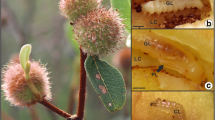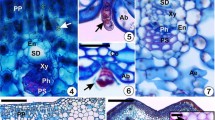Abstract
Gall cytological, metabolic, and structural traits are established due to the feeding habits of the associated galling herbivores, and sometimes are influenced by other organisms involved in the interaction. We tested this assumption on three gall morphotypes, the globoid, the lenticular, and the fusiform, induced by Cecidomyiidae on leaflets of Inga ingoides (Rich.) Willd. (Fabaceae: Caesalpinioideae). Taking for granted that the three Cecidomyiidae galls are induced on the same host plant and organ, we assume that the cytological and histochemical traits of their nutritive cells may be similar, but under the fungi influence, the ambrosia gall cytological profile may be peculiar and reflect on the accumulation of primary metabolites. The ambrosia globoid galls involve three organisms (host plant, gall inducer, and fungi), while the fusiform and the lenticular galls involve two organisms (host plant and gall inducer). The accumulation of primary metabolites is similar among the three gall morphotypes, except for the non-detection of reducing sugars in the fusiform galls. The fungi presence can impact the system but does not define exclusive features for the ambrosia globoid galls when compared to the lenticular and fusiform morphotypes. In fact, the cytological traits have revealed three different cytological mechanisms for food resources availability to the three galling Cecidomyiidae: (a) cell wall destructuring and cell death by fungi intermediation in the ambrosia globoid galls, (b) necrosis-type cell death in the fusiform galls, and (c) maintenance of continuous metabolic activity in the lenticular galls.




Similar content being viewed by others
Data availability
The data and material can be made available as needed.
Code availability
Not applicable.
References
Barnes WJ, Anderson CT (2018) Release, recycle, rebuild: cell-wall remodeling, autodegradation, and sugar salvage for new wall biosynthesis during plant development. Mol Plant 11:31–46. https://doi.org/10.1016/j.molp.2017.08.011
Bragança GP, Oliveira DC, Isaias RMS (2017) Compartmentalization of metabolites and enzymatic mediation in nutritive cells of Cecidomyiidae galls on Piper arboreum Aubl. (Piperaceae). J Plant Stud 6:11
Bragança GP, Alencar CF, Freitas MSC, Isaias RMS (2020) The dynamics of hemicelluloses-cellulose microfibrils and cell elongation axes determine gall morphotypes on Inga ingoides (Fabaceae). Plant Biol 22:981–991. https://doi.org/10.1111/plb.13151
Bragança GP, Freitas MSC, Isaias RMS (2021) The influence of gall position over xylem features in leaflets of Inga ingoides (Rich.) Willd. (Fabaceae: Caesalpinioideae). Trees 35:199–209. https://doi.org/10.1007/s00468-020-02027-1
Bronner R (1992) The role of nutritive cells in the nutrition of Cynipids and Cecidomyiids. In: Shorthouse JD, Rohfritsch O (eds) Biology of insect-induced galls. Oxford University Press, New York, pp 118–140
Brundett MC, Kendrick B, Peterson CA (1991) Efficient lipid staining in plant material with sudan red 7B or fluorol yellow 088 in polyethylene glycol-glycerol. Biotech Histochem 66:111–116. https://doi.org/10.3109/10520299109110562
Bukatsch F (1972) Bermerkungenzur Doppelfärbung Astrablau-Safranin. Mikrokosmos 61:255
Carneiro RG, Isaias RMS (2015) Cytological cycles and fates in Psidium myrtoides are altered towards new cell metabolism and functionalities by the galling activity of Nothotrioza myrtoidis. Protoplasma 252:637–646. https://doi.org/10.1007/s00709-014-0709-x
Castro AC, Oliveira DC, Moreira ASFP, Lemos-Filho JP, Isaias RMS (2012) Source–sink relationship and photosynthesis in the horn-shaped gall and its host plant Copaifera langsdorffii Desf. (Fabaceae). S Afr J Bot 83:121–126. https://doi.org/10.1016/j.sajb.2012.08.007
Cui Y, Shen J, Gao C, Zhuang X, Wang J, Jiang L (2016) Biogenesis of plant prevacuolar multivesicular bodies. Mol Plant. https://doi.org/10.1016/j.molp.2016.01.011
Cui Y, He Y, Cao W, Gao J, Jiang L (2018) The multivesicular body and autophagosome pathways in plants. Front Plant Sci 9:1837. https://doi.org/10.3389/fpls.2018.01837
Evert RF (2006) Esau’s plant anatomy: meristems, cells, and tissues of the plant body: their structure, function and development, 3rd edn. John Wiley & Sons Inc, Hoboken
Fahn A (1988) Secretory tissues in vascular plants. New Physiol 3:229–257. https://doi.org/10.1111/j.1469-8137.1988.tb04159.x
Fahn A (2000) Structure and function of secretory cells. In: Hallahan DL, Gray JC, Callow JA (eds) Advances in botanical research, incorporating advances in plant pathology. Academic Press, London, pp 37–66
Fernandes GW, Fagundes M, Woodman RL, Price PW (1999) Ant effects on three-trophic level interactions: plant, galls, and parasitoids. Ecol Entomol 24:411–415
Ferreira BG, Carneiro RGS, Isaias RMS (2015) Multivesicular bodies differentiate exclusively in nutritive fast-dividing cells in Marcetia taxifolia galls. Protoplasma 252:1275–1283. https://doi.org/10.1007/s00709-015-0759-8
Ferreira BG, Álvarez R, Avritzer SC, Isaias RMS (2017) Revisiting the histological patterns of storage tissues: beyond the limits of gall-inducing taxa. Botany 95:173–184. https://doi.org/10.1139/cjb-2016-0189
Ferreira BG, Bragança GP, Isaias RMS (2020) Cytological attributes of storage tissues in nematode and eriophyid galls: pectin and hemicellulose functional insights. Protoplasma 257:229–244. https://doi.org/10.1007/s00709-019-01431-w
Gagné RJ (1994) The gall midges of the Neotropical region. Cornell Univ. Press, Ithaca
Heller A (2019) Host-parasite interaction during subepidermal sporulation and pustule opening in rust fungi (Pucciniales). Protoplasma 257:783–792. https://doi.org/10.1007/s00709-019-01461-4
Harris MO, Freeman TP, Rohfritsch O, Anderson KG, Payne SA (2006) Virulent Hessian Fly (Diptera: Cecidomyiidae) larvae induce a nutritive tissue during compatible interaction with wheat. Ann Entomol Soc Am 99:305–316. https://doi.org/10.1603/0013-8746(2006)099[0305:VHFDCL]2.0.CO;2
Isaac S (1991) Fungal – plant interactions. Chapman and Hall, London
Isaias RMS, Ferreira BG, Alvarenga DR, Barbosa LR, Salminen J, Steinbauer MJ (2018) Functional compartmentalization of nutrients and phenolics in the tissues of galls induced by Leptocybe invasa (Hymenoptera: Eulophidae) on Eucalyptus camaldulensis (Myrtaceae). Aust Entomol 57:238–246. https://doi.org/10.1111/aen.12336
Johansen DA (1940) Plant microtechnique. McGraw-Hill, New York
Karnovsky MJ (1965) A formaldehyde-glutaraldehyde fixative of high osmolarity for use in electron microscopy. J Cell Sci 27:137–138
Kraus JE, Arduin M (1997) Manual básico de métodos em morfologia vegetal. Editora da Universidade Federal Rural do Rio de Janeiro, Seropédica
Luft JH (1961) Improvements in epoxy resin embedding methods. J Biophys Biochem Cytol 9:404–414. https://doi.org/10.1083/jcb.9.2.409
Luz FA, Mendonça Júnior MS (2019) Guilds in Insect Galls: Who is Who. BioOne 1:207–210. https://doi.org/10.1653/024.102.0133
Marques JPR, Soares MKM, Appezzato-da-Glória B (2013) New staining technique for fungal-infected plant tissues. Turk J Bot 37:784–787. https://doi.org/10.3906/bot-1204-9
Mazia D, Brewer PA, Alfert M (1953) The cytochemistry staining and measurement of protein with mercuric bromophenol blue. Biol Bull 104:57–67. https://doi.org/10.2307/1538691
Miller DG, Raman A (2018) Host–plant relations of gall-inducing insects. Ann Entomol Soc Am 112:1–19. https://doi.org/10.1093/aesa/say034
O’Brien TP, McCully ME (1981) The study of plant structure: principles and selected methods. Termacarphi Pty Ltd, Melbourne
Oliveira DC, Magalhães TA, Carneiro RGS, Alvin MN, Isaias RMS (2010) Do Cecidomyiidae galls of Aspidosperma spruceanum (Apocynaceae) fit the pre-established cytological and histochemical patterns? Protoplasma 242:81–93. https://doi.org/10.1007/s00709-010-0128-6
Oliveira DC, Carneiro RGS, Magalhães TA, Isaias RMS (2011) Cytological and histochemical gradients on two Copaifera langsdorffii Desf (Fabaceae) Cecidomyiidae gall systems. Protoplasma 248:829–837. https://doi.org/10.1007/s00709-010-0258-x
Paiva JGA, Fank-de-Carvalho SM, Magalhães MP, Graciano-Ribeiro D (2006) Verniz vitral incolor 500®: uma alternativa de meio de montagem economicamente viável. Acta Bot Bras 20:257–264. https://doi.org/10.1590/S0102-33062006000200002
Pan LY, Chen WN, Chiu ST, Raman A, Chiang TC, Yang MM (2015) Zool Sci 32:314–321. https://doi.org/10.2108/zs140244
Pennel R, Lamb C (1997) Programed cell death in plants. Plant Cell 9:1157–1168. https://doi.org/10.1105/tpc.9.7.1157
Raman A, Suryanarayanan TS (2017) Fungus-plant interaction influences plant-feeding insects. Fungal Ecol 29:123–132. https://doi.org/10.1016/j.funeco.2017.06.004
Reynolds ES (1963) The use of lead citrate at high pH as an electron-opaque stain in electron microscopy. J Cell Biol 17:208–212. https://doi.org/10.1083/jcb.17.1.208
Rezende UC, Custódio JF, Kuster VC, Gonçalves LA, Oliveira DC (2019) How the activity of natural enemies changes the structure and metabolism of the nutritive tissue in galls? Evidence from the Palaeomystella oligophaga (Lepidoptera)–Macairea radula (Metastomataceae) system. Protoplasma 256:669–667. https://doi.org/10.1007/s00709-018-1321-2
Rohfritsch O (1992) Patterns in gall development. In: Shorthouse JD, Rohfritsch O (eds) Biology of insect-induced galls. Oxford University Press, New York, pp 60–86
Rohfritsch O (2008) Plants, gall midges, and fungi: a three-component system. Entom Exp Appl 128:208–216. https://doi.org/10.1111/j.1570-7458.2008.00726.x
Sass JE (1951) Botanical microtechnique. Iowa State College Press, Ames
Sillo F, Fangel JU, Henrissat B, Faccio A, Bonfante P, Martins F, Willats WGT, Balestrini R (2016) Understanding plant cell-wall remodelling during the symbiotic interaction between Tuber melanosporum and Corylus avellana using a carbohydrate microarray. Planta 244:347–359. https://doi.org/10.1007/s00425-016-2507-5
Stone GN, Schonrögge K (2003) The adaptive significance of insect gall morphology. Trends Ecol Evol 18:512–522. https://doi.org/10.1016/S0169-5347(03)00247-7
Van Doorn WG, Woltering EJ (2005) Many ways to exit? Cell death categories in plants. Trends Plant Sci 10:117–122. https://doi.org/10.1016/j.tplants.2005.01.006
Van Doorn W, Beers E, Dangl J, Franklin-Tong V, Gallois P, HaraNishimura I, Jones A, Kawai-Yamada M, Lam E, Mundy J (2011) Morphological classification of plant cell deaths. Cell Death Differ 18:1241–1246. https://doi.org/10.1038/cdd.2011.36
Weis AE (1982) Resource utilization patterns in a community of gall-attacking parasitoids. Environ Entomol 11:809–815. https://doi.org/10.1093/ee/11.4.809
Yukawa J, Rohfritsch O (2005) Biology and ecology of gall inducing Cecidomyiidae (Diptera). In: Raman A, Schaefer CW, Withers TW (eds) Biology, ecology, and evolution of gall-inducing Arthropods. Science Publishers, Enfield, pp 273–304
Acknowledgements
We thank Centro de Microscopia of Universidade Federal de Minas Gerais (CM-UFMG) for the analyses in transmission electron microscopy.
Funding
This study was financed by the Coordenação de Aperfeiçoamento de Pessoal de Nível Superior—Brasil (CAPES)—Finance Code 001 for G.P.P. Bragança (88882.184378/2018–01) scholarship and by Conselho Nacional de Desenvolvimento Científico e Tecnológico (CNPq) for R.M.S. Isaias research fellowship (304335/2019–2). The current study was also supported by the Fundação de Amparo à Pesquisa do Estado de Minas Gerais (FAPEMIG).
Author information
Authors and Affiliations
Contributions
GPPB, RMSI, and BGF designed the experiments. GPB collected material and performed the experiments. All authors analyzed the results, discussed data, wrote, and reviewed the manuscript. RMSI coordinated the project.
Corresponding author
Ethics declarations
Ethics approval
Not applicable.
Consent to participate
Not applicable.
Consent for publication
Not applicable.
Conflict of interest
The authors declare no competing interests.
Additional information
Handling Editor: Hanns H. Kassemeyer
Publisher’s note
Springer Nature remains neutral with regard to jurisdictional claims in published maps and institutional affiliations.
Rights and permissions
About this article
Cite this article
Bragança, G.P.P., Ferreira, B.G. & Isaias, R.M. Distinct cytological mechanisms for food availability in three Inga ingoides (Fabaceae)—Cecidomyiidae gall systems. Protoplasma 259, 155–162 (2022). https://doi.org/10.1007/s00709-021-01646-w
Received:
Accepted:
Published:
Issue Date:
DOI: https://doi.org/10.1007/s00709-021-01646-w




